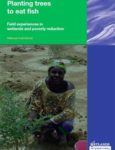This book draws on the experiences of four projects (in Indonesia, Kenya, Zambia/Malawi and Mali) that combined conservation and development goals. The four projects demonstrated – each in a different way – how improving livelihoods and conserving wetlands can go hand in hand. The book tells the story of the problems that the individual projects faced, and how they were addressed. In addition, there is a review of seven other wetland-based projects from around the world.

Trees for Fish
downloadDescription
Conservation organisations value wetlands for the richness of their biodiversity – especially for their birds, fish and plants. Conservationists want to see wetlands preserved. Many governments and development organisations, on the other hand, see wetlands as unexploited resources or a hindrance to development:as essential supplies of water for domestic and irrigation needs, as land to be drained for agriculture and forestry, or simply as wastelands infested with mosquitoes.
Environmental sanctuaries
The truth is that wetlands are vital environmental sanctuaries, critical to the viable functioning of the ecosystems in which we all live. More specifically, wetlands are the sources of livelihood for the people – often poor farmers and fishers – who live in and around them. The subject of this book is the challenge of reducing
poverty whilst at the same time as conserving the biological and intrinsic values of wetlands.
The book draws on the experiences of four projects with financial support from Wetlands International, in Indonesia, Kenya, Zambia/Malawi and Mali, that combined conservation and development goals.
Improving livelihoods and conserving wetlands can go hand in hand
The four projects demonstrated – each in a different way – how improving livelihoods and conserving wetlands
can go hand in hand. The book tells the story of the problems that the individual projects faced, and how they were addressed. In addition, there is a review of seven other wetland-based projects from around the world. Each project is analysed in terms of six cross-cutting themes: poverty and livelihoods, biodiversity and ecosystem services, water management, community engagement, policy, and project management.
Written by and for practitioners
The book is written by and for practitioners involved in planning and managing conservation or development projects in wetlands. The book should also be an aid to policy makers and all those trying to reconcile the apparently conflicting goals of environment and development programmes.